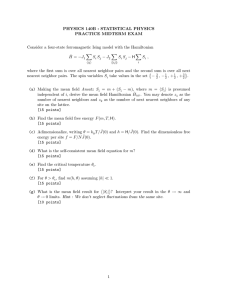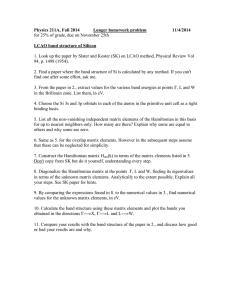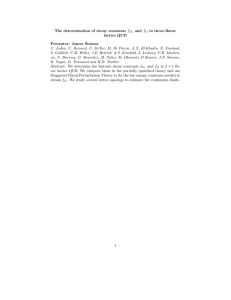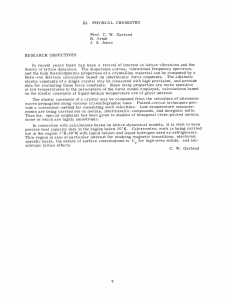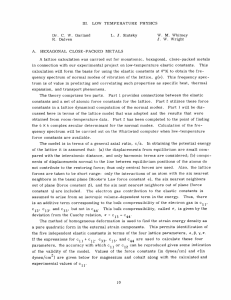Department of Electrical Engineering and Computer Science Massachusetts Institute of Technology Introduction
advertisement
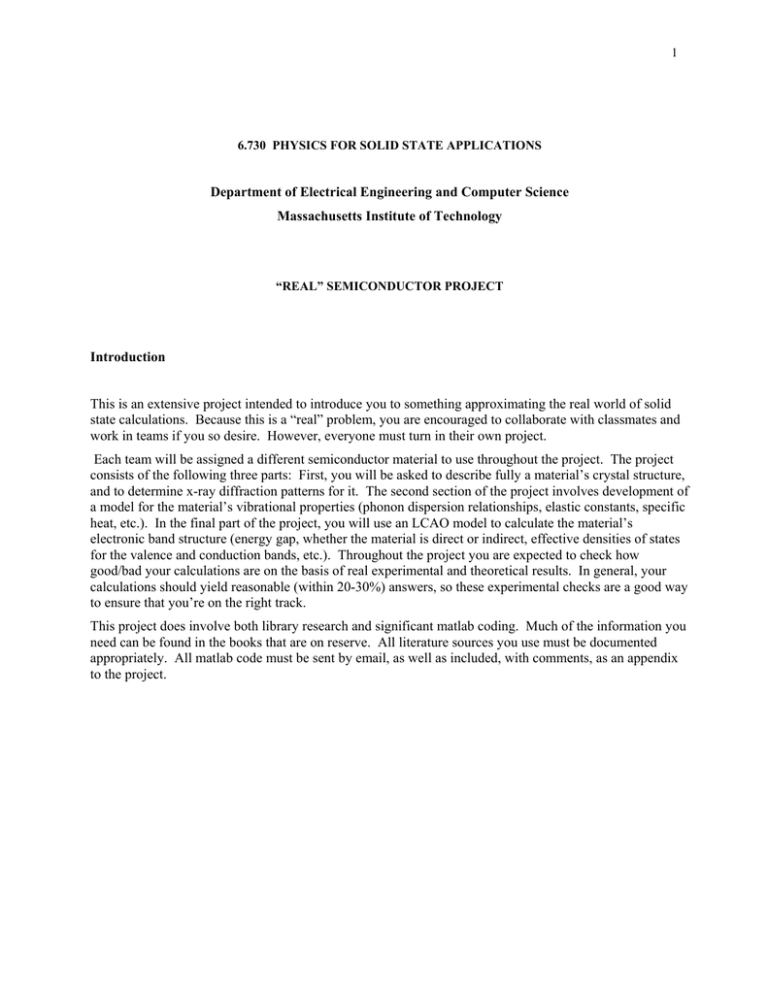
1 6.730 PHYSICS FOR SOLID STATE APPLICATIONS Department of Electrical Engineering and Computer Science Massachusetts Institute of Technology “REAL” SEMICONDUCTOR PROJECT Introduction This is an extensive project intended to introduce you to something approximating the real world of solid state calculations. Because this is a “real” problem, you are encouraged to collaborate with classmates and work in teams if you so desire. However, everyone must turn in their own project. Each team will be assigned a different semiconductor material to use throughout the project. The project consists of the following three parts: First, you will be asked to describe fully a material’s crystal structure, and to determine x-ray diffraction patterns for it. The second section of the project involves development of a model for the material’s vibrational properties (phonon dispersion relationships, elastic constants, specific heat, etc.). In the final part of the project, you will use an LCAO model to calculate the material’s electronic band structure (energy gap, whether the material is direct or indirect, effective densities of states for the valence and conduction bands, etc.). Throughout the project you are expected to check how good/bad your calculations are on the basis of real experimental and theoretical results. In general, your calculations should yield reasonable (within 20-30%) answers, so these experimental checks are a good way to ensure that you’re on the right track. This project does involve both library research and significant matlab coding. Much of the information you need can be found in the books that are on reserve. All literature sources you use must be documented appropriately. All matlab code must be sent by email, as well as included, with comments, as an appendix to the project. 2 Part I: Crystal Structure This part of the project is relatively simple, but it does lay important ground work for the second and third parts of the project. When you do the research for this section, be sure to make copies of any information you find on your material--it will come in handy for parts II and III. Do appropriate research to answer the following questions about your material: 1. What is the crystal structure? 2. What is the lattice constant? 3. What is the basis? 4. What are the primitive lattice vectors? 5. What is the structure of the reciprocal lattice? 6. What are the primitive reciprocal lattice vectors? 7. What are the atomic form factors for your material? The following can be done by hand, or by using matlab where appropriate: 1. Provide pictures of the crystal and of the reciprocal lattice in the [100], [110], and [111] planes. Indicate the vertical positions of atoms with respect to the plane (see, for example, Kittel p. 19). 2. Calculate the structure factor for all reciprocal lattice vectors G of magnitude |G|2 < 16(2π/a)2. Be sure to include the atomic form factors. 3. Describe in detail an experimental setup you could use to determine the crystal structure of your material by x-ray diffraction. Provide appropriate figures. Specify what wavelength(s) of x-ray is(are) necessary in your setup. Suggest possible sources. 4. Calculate and draw the expected x-ray diffraction pattern(s) from your setup. Discuss (with calculations) how the pattern(s) would be used to determine the crystal structure. 5. Try to find experimental results for x-ray diffraction on your material. Compare with your predicted results and comment on any discrepancies you find. 3 6.730 PHYSICS FOR SOLID STATE APPLICATIONS Department of Electrical Engineering and Computer Science Massachusetts Institute of Technology “REAL” SEMICONDUCTOR PROJECT Part II: Phonons In this part of the project, you will be developing a simple model for the phonon spectra of your semiconductor. The game plan here is to develop a general model for the phonon dispersion relationship, in terms of some unknown force constants, and then to use experimental data to fit the force constants to the material. The model you will be using is a Born force constant model that incorporates bond bending and bond stretching, as we discussed in class. A. Background Questions For the Born force constant model, we can consider just nearest neighbor interactions, or we can make the model more accurate (and more complicated) by including next nearest neighbors, next-next nearest neighbors, etc. Before beginning on your calculation, answer the following general questions about the Born model: 1. How many force constants are required for each bond? Why? 2. What is the energy of a single bond in the Born model? 3. The model assumes that the bond is only slightly displaced from equilibrium. How would you modify the model to make the bond energy more realistically dependent on displacement from equilibrium-what order would the corrections be, and of what sign? Justify your answer physically; include sketches if appropriate. 4. If you use only nearest-neighbor couplings, how many force constants will your model require for your material? How large will the dynamical matrix be? What if you use nearest neighbor and next nearest neighbor couplings? 5. How many independent elastic constants does your material possess? What are they (give numbers)? Why will a nearest-neighbor approach not provide the most general solution for a cubic material? B. Construction of Dynamical Matrix In fact, a nearest neighbor calculation that accounts for bond bending actually does a good job (within 20%), and is significantly more tractable than the next nearest neighbors approach. We will therefore start out with a nearest neighbors approach; next nearest neighbors will be left as an extra credit bonanza for the diligent among you. 1. Draw all the atoms in the basis and all their nearest neighbors. Label the atoms according to their lattice vector and basis vector. 4 2. Write a general expression for the potential energy of all the atoms in the crystal in terms of their displacement from equilibrium. Use a Born force model which considers only nearest neighbor interactions to simplify this expression (your expression should contain force constants and displacements at this point). 3. Use your simplified expression for the potential energy to determine the force on a given atom in the crystal in terms of its displacement and its neighbors’ displacements. Check your answer by directly calculating the force from the spring constants and displacements. 4. Use your simplified expression for the potential energy to calculate the dynamical matrix. Is it Hermitian? 5. Write a matlab code to find the phonon spectra for general values of your force constants and atomic masses. Plot the phonon dispersion in appropriate units along the Γ-X, X-L, and Γ -L directions using force constants of αBEND=1, αφ=0.25, and M1=M2=1. 6. For these values of force constants and masses, determine the atomic displacements for all the modes at Γ, and for the highest optic and lowest acoustic modes at X and L. Provide drawings of the atomic motion of these modes. How many modes are there at Γ? C. Model Optimization and Comparison to Macroscopic Properties Look up experimental results for phonon dispersion in your material. Using whatever criteria you deem appropriate (sound velocities, elastic constants, zone edge frequencies, etc.), determine optimum values of your force constants to match measured results. Calculate sound velocities, zone edge frequencies, and elastic constants (c11, c12, and c44) using your model and compare with values from the literature. Show all your calculations. Using your model, do the following: 1. Plot a comparison of your calculated phonon dispersion with theoretical and/or experimental results along the Γ-X, X-L, and Γ -L directions. 2. Plot the total density of states (histogram method, include all modes) versus frequency. 3. Calculate the specific heat of your material versus temperature using (a) your calculated density of states, (b) a Debye model, and (c) a combined Debye-Einstein model (Debye for acoustic modes, Einstein for optical modes). Plot your results for temperatures between 0 K and 3ΘD. Comment on the strengths and weaknesses of your model. If you so desire, extend it to next nearest neighbors (this is not required, but if you’re bored one Saturday night...) 5 6.730 PHYSICS FOR SOLID STATE APPLICATIONS Department of Electrical Engineering and Computer Science Massachusetts Institute of Technology “REAL” SEMICONDUCTOR PROJECT Part III: Electronic Band Structure In this part of the project, you will be developing an LCAO picture for the valence and conduction bands of your semiconductor. As in the phonon part of the project, you will first develop a general form for the solution. You will then apply that form to your material, compare your calculated results with results reported in the literature, and use your results to evaluate physically interesting material properties. A. Background Questions - Before developing the Hamiltonian matrix, answer the following general questions about the LCAO method: 1. For our LCAO model we construct extended orbital basis functions, |χα(k)>, which are in turn used to construct our trial wave function, |ψ(k)>. Typically use only the outermost (highest principal quantum number) orbitals to construct our different |χα(k)>, so that in a system with b atoms in the basis and n outermost orbitals per atom, the total number of extended orbital basis functions is nb. How many extended orbital basis functions will you have for your material? Why? 2. Conceivably one could also construct |χα(k)> out of core orbitals as well as valence orbitals. If you did so, how many extended orbital basis functions would you have to use for your material? How large would your Hamiltonian matrix be in this case? How do you expect your results would differ from those you would get with just valence orbitals? What if we used higher (totally unoccupied) orbitals, too? How many orbitals per atom would we have to use to get an “exact” band structure? Why? B. Construction of Hamiltonian Matrix 1. What are the atomic configurations of the two atoms in your material? Which orbitals do you expect to play a significant role in bonding? 2. Draw all the atoms in the basis and all their nearest neighbors with appropriate orbitals on each atom. Label the orbitals according to their lattice vector, basis vector, orbital type, and the type atom they are associated with (cation or anion). For example, the s orbital on the cation at lattice vector R, basis vector τ would be labeled |φsc(R+τ)> 3. Show that one can approximate all the nearest neighbor interactions with one of the following (to within a sign). Pictorial arguments (with accompanying explanation) are acceptable. Ess=<φsc(0)|H|φsa(a/4,a/4,a/4)> Esp=<φsc(0)|H|φpxa(a/4,a/4,a/4)> Exx=<φpxc(0)|H|φpxa(a/4,a/4,a/4)> Exy=<φpxc(0)|H|φpya(a/4,a/4,a/4)> Is this approximation reasonable? Comment on the validity of <φsc(0)|H|φpxa(a/4,a/4,a/4)> = <φsa(0)|H|φpxc(a/4,a/4,a/4)> Given this approximation, can we write <φsc(0)|H|φsc(0)> = <φsa(a/4,a/4,a/4)|H|φsa(a/4,a/4,a/4)> ? Calculate values for Ess, Esp, Exx, and Exy in terms of Vssσ, Vspσ, etc. (see PS 6). 4. Construct a set of extended atomic orbitals. Be explicit about your choice of phase factors. Write your trial wave function as a linear combination of these extended orbitals. 6 5. Find the Hamiltonian matrix for the nearest neighbor approximation. Your answer should contain only Ess, Esp, Exx, Exy, the s and p energies of the anion and cation (Esa, Esc, Epa, and Epc) and phase factors. NOTE: You will be able to find this matrix in the literature. However, several of the sources (including Harrison, 1980 and Slater and Koster, 1954) have minor errors in their matrices or matrix elements, so check your answer carefully. If you are really motivated, find H for next-nearest neighbors, too... C. Band Calculations 1. Look up a “real” energy band diagram for your material. Include a copy in your report. 2. Write a matlab program to plot the free-electron band structure for your material along the same directions as used in the energy band you found in the literature [Note: neglecting factors of π/a, the symmetry points are Γ =(0,0,0); X=(1,0,0); L = (1/2, 1/2, 1/2); K=(3/4, 3/4, 0); and W=(1, 1/2, 0)]. Indicate the degeneracies of the different bands. Where is the Fermi level located? How does the free electron band structure compare to the real band structure? 3. Algebraically diagonalize the Hamiltonian matrix at the Γ point. What are the different energies and eigenvectors, and what do they correspond to physically (hint: look back at PS 1)? Using Harrison’s Solid State Table (attached) find numerical values for Esa, Esc, Epa, Epc, Ess, Esp, Exx, and Exy. Compare your calculated energies at the Γ point with values from the literature. 4. Write a matlab program to plot the LCAO energy bands along the same directions as above, along with the approximate location of the Fermi level. How do your results compare (qualitatively) with the band structure you found in the literature? If you wish, optimize the matrix elements for your material. 5. Where are the valence band maximum and the conduction band minimum located? What is the energy gap? Is your material direct or indirect? D. Effective Masses, Constant Energy Surfaces, Density of States - Since you are working in 3D, it will probably prove rather challenging to plot the 3D constant energy surfaces near the valence band and conduction band edges. If you can figure out a good way to do this (that doesn’t involve making an effective mass approximation) you will be rewarded with many bonus points and a Toscanini’s gift certificate. Failing that, 1. Plot constant energy contours near the valence and conduction band edges for “appropriate” planes. For example, if your minimum is at kmin along Γ-X, you should probably plot an energy contour for the kx-ky plane, and for the plane parallel to ky-kz that contains kmin. For a minimum along Γ-L, the plane containing the Γ-L direction and the plane perpendicular to that direction would make sense. 2. Solve for the energy at a number of k points near the valence and conduction band edges. Fit these points using a quadratic polynomial (be sure to think about your results from D1 when you do this). Use your results to find the effective masses for both the valence bands and the conduction band. How do your results compare with results from the literature? How would you improve your results? 3. Plot the total density of states (histogram method, include all bands) versus energy. Use your calculated effective masses to determine an approximate expression for the density of states near the valence and conduction band edges. How does this calculation compare with the total D.O.S.? 4. Using your total D.O.S., calculate the electronic specific heat of your material as a function of temperature. Compare this with your calculations for the phonons, and comment. 5. Use the band structure you found in the literature to discuss the characteristics of your material. What electronic/optical applications would your material be good/bad for? Why? 7 6.730 PHYSICS FOR SOLID STATE APPLICATIONS Department of Electrical Engineering and Computer Science Massachusetts Institute of Technology “REAL” SEMICONDUCTOR PROJECT Your assigned material is: 3C-SiC AlAs GaP-I GaAs InP InAs GaSb-I
